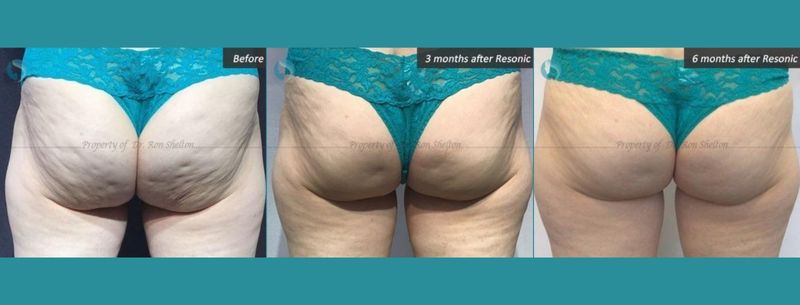Cellulite Treatment NYC
Described as resembling cottage cheese or the surface of an orange peel, some dimples may only appear when the skin is pinched while severe cases have rumpled, bumpy surfaces with peaks and valleys.
Cellulite typically occurs on the hips, butt, thighs, tummy, breasts, and upper arms — areas where fat is distributed among even the leanest women.
What is the main cause of cellulite?
Your skin is made up of fibrous connective cords, fat cells, and underlying muscle. As the fat cells push up against the skin, the fibrous connective cords tethering skin to muscle are pulled down. This tension creates uneven surfaces, bumps, and dimples.
Fat cells accumulate and cellulite looks more noticeable following weight gain and inactivity; however, it is estimated around 80 percent of post-adolescent women have it, regardless of size, weight, fitness, and diet.
Genetics play a role, and cellulite may become more noticeable as you get older and the body produces less collagen and elastin responsible for skin’s tautness and firmness.
Traditional treatment for cellulite
Like the latest anti-aging cream, many are marketed as wonder treatments for cellulite. Typically, they don’t live up to their claims.
Furthermore, while weight loss reduces the appearance of dimples and peaks by shedding fat cells and bulking up muscle, cellulite can’t be treated with fitness and diet alone.
On the other end of the spectrum, liposuction may surgically suction out fat cells. This procedure is not appropriate for every woman. As with any surgical procedure, there are risks including infection, numbness, and fluid accumulation. It may take weeks before you can return to normal activities, and swelling and discomfort can last just as long.
Although some cases of cellulite improve after liposuction, the procedure does not have a specific indication for this condition. Rarely, indentations can actually occur after liposuction.
Procedures used with off-label applications to help reduce cellulite:
-
-
-
- ThermiSmooth
- ThermiTight
- Cellfina
- Subcision
- Thermage
-
-
While dimples may be cute on the face, the same cannot be said of the lumps and bumps that plague the majority of women. Traditionally there have been few effective ways to treat cellulite until now.
What is the best treatment for cellulitis?
The best treatments are those combining proven approaches with the latest proprietary technologies science has to offer. Cellfina™ uses subcision, a subcutaneous incision-free approach historically used to treat other textural inconsistencies such as scars. This approach is accompanied by vacuum-assisted technology.
The Cellfina™ answer
Dr. Ron Shelton is qualified to treat cellulite safely and effectively with a procedure designed specifically for this purpose. The Cellfina™ System treats cellulite in a minimally invasive way.
Cellfina™ is the only FDA-cleared treatment that has been clinically proven to reduce the appearance of cellulite for at least one year. Cellfina™ represents the longest FDA clearance for the treatment of cellulite.
How it works
The best treatments are those combining proven approaches with the latest proprietary technologies science has to offer. Cellfina™ uses subcision, a subcutaneous incision-free approach historically used to treat other textural inconsistencies such as scars. This approach is accompanied by vacuum-assisted technology.
Cellfina™ targets those bands that pull down the skin. As Dr. Shelton comfortably and gently applies a needle-sized device to the treatment areas, the pulled-down bands are released. With the bands no longer under tension, the skin is able to bounce back just like a rubber band might. By stimulating the release of these tight bands, the bumps, peaks, and valleys are smoothed.
You can see results from the 45 to 60 minute treatment in about three days. Due to the minimally invasive nature of the procedure, there is no healing time. Bruising from Cellfina™ may last a few weeks, but can resolve in much less time.

